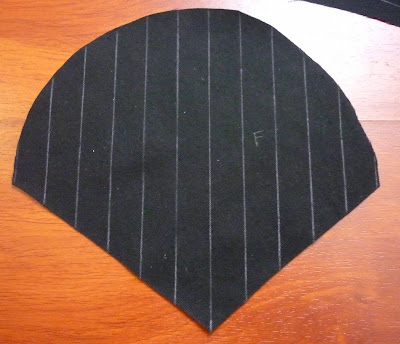For all quilted portions of the jacket, you will need your walking/quilting foot and quilting needles.
A universal foot will not work well for this; a sewing machine only has feed dogs (the things on the sewing plate, beneath the foot, that pull the fabric forward as you sew) on the bottom, so the uppermost layers of fabric will move at a slower speed than the bottom ones, and by the time you reach the end of the quilt line, your pieces will have slid slightly, no matter how well you pin them.
(It's like trying to eat a burger while only holding the bottom half of the bun; you might get some of the top half in each bite, but it'll probably keep sliding back as you eat.)
The pattern pieces to be quilted are the two front yokes (piece A), the back yoke (piece B), and the two shoulder points (piece L).
To start, you should have three cuts for each pattern piece: shell (wool elastique/cavalry twill), batting (sew-in fleece, low-loft polyester, anti-pill fleece, etc.), and backing (we recommend using the jacket body fabric - wool gabardine or cotton twill).
Using your tailor's/dressmaker's white pencil, copy the quilt lines exactly from the printed pattern onto your backing fabric. They are precisely ¾" apart, so an easy way to do this is to mark the top and bottom of each piece then use a see-through quilter's ruler to mark them and ensure they're exactly parallel.
We highly recommend reducing bulk in by cutting out the batting and backing in the following key areas:
* along the front opening and neckline
* at the neckline and armscye edges of the shoulder seam
* at the armscye edges of the front and back yoke/body seams
We recommend reducing the bulk by ⅜", plus the height of your quilted assembly (for "turn of cloth") - ⅛" should be sufficient, resulting in a bulk reduction of about ½" in the aforementioned areas.
We also recommend marking these bulk-reducing areas on your backing pieces (⅜" marked in these photos).
You may also wish to mark key quilt lines.
While you're at it, you can mark the front of your shoulder point so you can tell at a glance which one it is:
Stack the three layers of each piece on top of each other: shell, right side up, batting, and backing (so that the batting is sandwiched in the middle).
We highly recommend spraying some temporary fabric adhesive between the layers; even with pinning and the use of a walking foot, the layers can still slide around a bit, causing unsightly puckering and/or misalignment.
Once the layers are loosely secured together, cut away the backing and backing at the aforementioned areas as described previously.
 |
| (Bottom photo is of the finished DS9/NEM jumpsuit yoke) |
Pin the layers together, then baste the perimeter of the assembly ⅛" or ¼" from the outside edges to further secure them.
Using your quilting/walking foot (and gray thread), quilt along the lines indicated from the wrong side.
Once quilted, it will look like this:
Serge the entire quilted assembly.
Repeat this process for the other quilted pattern pieces.
TIP: The back yoke will likely tend to contract somewhat due to the compound effect of slightly curved quilt lines - i.e. the flat fabric curves slightly over the batting between the stitch lines, thus ultimately making the back yoke too small from side to side - so pull the two ends apart while you quilt to minimize this effect. You might also want to quilt every other, or perhaps every third, quilt line then go back and "fill them in later."
TIP: The spray adhesive will likely leave your finished pieces feeling rather stiff, so spray or briefly soak them in water to dissolve and/or wash out the adhesive, then set them aside to dry.
PREVIOUS: Tutorial, part 1 - Pattern Pieces
NEXT: Tutorial, part 3 - Yoke Trim
PREVIOUS: Tutorial, part 1 - Pattern Pieces
NEXT: Tutorial, part 3 - Yoke Trim
















.JPG)

No comments:
Post a Comment